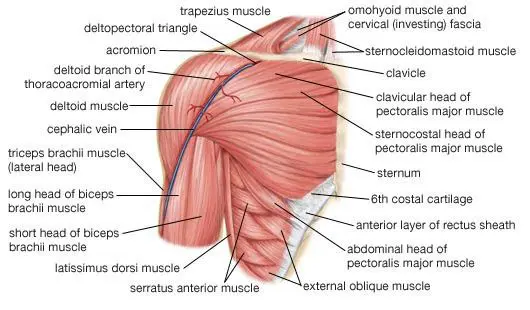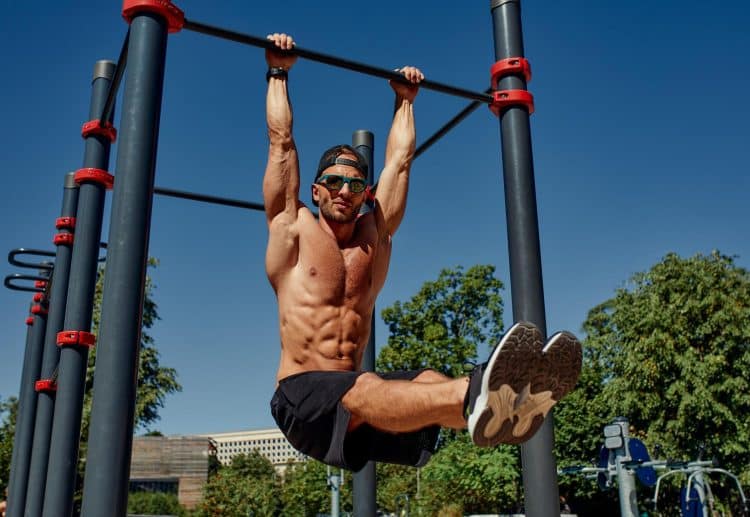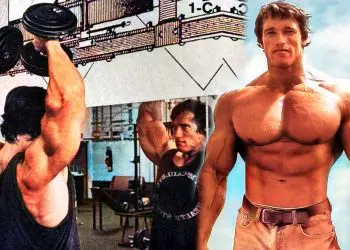Calisthenics, a time-honored favorite for developing functional strength and an aesthetic physique, involves classic bodyweight exercises like push-ups, pull-ups, squats, and more advanced moves like pistol squats and muscle-ups. These exercises can be performed almost anywhere, making them highly accessible and effective.
However, as an experienced fitness professional with over 30 years in powerlifting, bodybuilding, and sports conditioning, I know that the effectiveness of calisthenics is significantly enhanced when following a well-designed routine. Random exercise selection often leads to suboptimal results. Drawing on my extensive knowledge and qualifications, including a College Diploma in Physical Education, a Premier Global Diploma in Personal Training & Sports Massage, and certification as a BAWLA L2 Weightlifting Coach and YMCA Group Exercise Instructor, I understand the importance of structured training for maximum benefit.
In this article, I will unveil the ten best calisthenics shoulder exercises, backed by my expertise in calisthenic and weight management. I’ll also provide a sample shoulder-building workout, ensuring that you have a reliable and effective guide to follow.
The 10 Best Calisthenic Shoulder Exercises
Build the shoulders you’ve always dreamed of with the top ten calisthenic shoulder exercises! Please note that while all three deltoid heads are involved in all these exercises, we’ve only listed the most active. The following calisthenic shoulder movements are presented roughly in order of difficulty.
1. Arm circles
Muscles targeted: Anterior, medial, and posterior deltoids, upper trapezius.
This simple exercise is an excellent way to warm up your shoulders before moving on to more strenuous movements. Alternatively, you can use it at the end of your workout to finish off your deltoids. This is a popular exercise in many traditional martial arts, including judo and karate.
Level Up Your Fitness: Join our 💪 strong community in Fitness Volt Newsletter. Get daily inspiration, expert-backed workouts, nutrition tips, the latest in strength sports, and the support you need to reach your goals. Subscribe for free!
Steps:
- Stand with your feet together and your arms by your sides. Bend your knees slightly, pull your shoulders back and down, and brace your core.
- Raise your arms up and out to the side to form a T shape. Your palms should be facing the floor.
- Make small circles with your arms for the prescribed number of reps or until the burning in your shoulders becomes unbearable.
- Lower your arms, rest a moment, and repeat.
Tips:
- Circle your arms forward or backward for variation.
- Keep your neck and face as relaxed as possible, and don’t forget to breathe.
- You can move your arms forward to hit different deltoid muscle fibers.
2. Isometric rear deltoid fly
Muscles targeted: Posterior deltoid, middle trapezius, rhomboids.
The posterior or rear deltoid is notoriously hard to train. As a result, a lot of people have very underdeveloped rear delts. This can have an adverse effect on posture, shoulder function, and health. You only need an open doorway to do the isometric rear delt fly, making it a very convenient way to train the back of your shoulders.
Steps:
- Stand in an open doorway.
- Raise your arms and place the back of your elbows against the doorframe. Brace your core and pull your shoulders back and down.
- Press your arms back against the doorframe as hard and long as possible.
- Relax, rest, and then repeat.
Tips:
- You can also do this exercise with your arms bent, making it more of a row than a fly.
- Push as hard as you can for a short time, or press for longer with less effort as preferred.
- No doorway available? You can replicate this exercise against a wall or lying on the floor:
3. Isometric lateral raise
Muscles targeted: Medial deltoid, upper trapezius.
While the medial deltoids are involved in most calisthenic shoulder exercises, this is probably the only exercise to emphasize them. The medial deltoid is the part of your shoulders that gives your upper body its width. So, if you want a V-taper, this exercise deserves a place in your workout.
Steps:
- Stand in an open doorway.
- Place your forearms and elbows against the inside of the doorframe.
- Press your arms out against the doorframe as hard and long as possible.
- Relax, rest, and then repeat.
Tips:
- Do not hold your breath, as doing so can elevate your blood pressure and make you feel faint.
- Push as hard as you can for a short time, or press for longer with less effort as preferred.
- You can also do this exercise with bent arms.
4. Plank shoulder taps
Muscles targeted: Anterior deltoid, trapezius, rhomboids.
While planks are generally considered to be a core exercise, the arm-switching motion of this variation means your arms and shoulders are also involved. You’ll need to use your deltoids to stabilize your upper body, so they’ll get an effective albeit isometric (static) workout.
Steps:
- Adopt the push-up position with your arms, legs, and body straight. Your hands should be shoulder-width apart. Brace your abs and pull your shoulders back and down.
- Shift your weight across onto one hand, bend your other arm, and touch your opposite shoulder with your hand.
- Return to the push-up position, switch sides, and repeat.
- Continue alternating arms for the required number of reps or duration.
Tips:
- Keep your shoulders and hips level throughout.
- Bend your legs and rest on your knees to make this exercise easier.
- Place your feet wider than shoulder distance apart to increase stability and make it easier to balance.
5. Decline push-ups
Muscles targeted: Pectoralis major, anterior deltoids, triceps.
Push-ups are arguably the most popular calisthenic exercise on the planet. Normally thought of as a chest exercise, push-ups also involve your shoulders. Raising your feet puts more weight on your hands and increases anterior deltoid engagement. Decline push-ups are a potent anterior shoulder exercise.
Steps:
- Adopt the push-up position with your hands slightly wider than shoulder-width apart and your feet on a knee-high box or bench. Brace your core.
- Keeping your body straight, bend your arms and lower your chest to within an inch of the floor.
- Push yourself back up and repeat.
Tips:
- The more you raise your feet, the more shoulder-centric this exercise becomes.
- Do not allow your hips to sag, as doing so puts a lot of stress on your lower back.
- Experiment with the width of your hands to see what feels most comfortable and effective.
6. Pike push-ups
Muscles targeted: Pectoralis major, anterior deltoids, triceps.
Go to the gym, and you’ll usually see people doing overhead presses to work their shoulders. Pike push-ups replicate this movement using your body weight. You’ll need good hip mobility to perform this exercise, but if you can do it, your shoulders will get a great workout.
Steps:
- Adopt the push-up position with your hands roughly shoulder-width apart. Brace your core and lift your hips into the air so your body resembles an inverted V or pike shape.
- Bend your arms and lower your head down toward the floor.
- Drive your palms into the floor and extend your arms.
- Continue for the desired number of reps.
Tips:
- Use push-up bars or parallettes to increase your range of motion and the difficulty of this exercise.
- Move your feet forward or back to find the most comfortable position for your hips.
- Put more weight on your hands by resting your feet on an exercise bench:
7. Archer push-ups
Muscles targeted: Pectoralis major, anterior deltoids, triceps.
Most calisthenic shoulder exercises train both sides of your body at the same time. This exercise is a little different and allows you to alternate sides. This is useful not just for variety but also for ensuring both shoulders and arms are developed equally.
Steps:
- Adopt the push-up position with your hands slightly wider than shoulder-width apart. Brace your core and pull your shoulders back and down.
- Shift your body weight to one side, keeping the opposite arm straight and the fingers firmly planted on the ground.
- Bend your supporting arm, lowering your chest towards the hand on that side. Keep the opposite arm extended.
- Push back up to the starting position and repeat the same movement on the other side.
- Alternate sides for the required number of reps.
Tips:
- Keep your core braced throughout the movement to maintain stability.
- Descend slowly and then push up explosively to fully engage your muscles.
- Keep your body straight from head to heels throughout the exercise.
8. Wide-grip inverted row
Muscles targeted: Posterior deltoid, trapezius, rhomboids, biceps.
Rows are usually thought of as back exercises – which they are. However, performed with a wide, overhand grip, they’re also an excellent movement for your posterior deltoids, mid-traps, and rhomboids. Wide-grip inverted rows are a very valuable posture exercise and deserve a place in almost everybody’s workout.
Steps:
- Sit below a waist-high bar, such as a barbell in a squat rack, Smith machine, or single portable dip bar, e.g., Lebert Equalizer.
- Hold the bar with an overhand wider than shoulder-width grip. Lean back so your arms are straight.
- Lift your hips up so your body is straight. Brace your core and pull your shoulders down and back.
- Bend your arms and pull your chest up to the bar.
- Extend your arms and repeat.
Tips:
- Drive your elbows back and keep your wrists straight to maximize muscle engagement.
- Bend your legs to take weight off your arms and make this exercise easier.
- Place your feet on a bench or step to make this move harder.
9. Wall walks
Muscles targeted: Anterior deltoids, medial deltoids, triceps, upper trapezius, core.
Wall walks are a challenging upper body and shoulder exercise from CrossFit. They combine push-ups with handstands to thoroughly thrash your deltoids and triceps. This is a strenuous exercise, so only attempt it if you are feeling strong.
Steps:
- Adopt the push-up position with your arms bent and chest touching the floor. Your feet should be against the bottom of a smooth wall.
- Extend your arms, walk your hands back, and move your feet up the wall until you are fully inverted, with your chest and thighs touching the wall.
- Walk your hands forward and your feet down until you’re back in the push-up position.
- Do a single push-up and repeat.
Tips:
- Keep your core braced and your body straight throughout.
- Perform the exercise slowly and with control to improve balance and stability.
- Maintain a straight line from your wrists to your shoulders, hips, and heels throughout the movement.
10. Handstand push-ups
Muscles targeted: Anterior deltoids, medial deltoids, triceps, upper trapezius, core.
Calisthenic shoulder exercises don’t come much more challenging than handstand push-ups. After all, you’ll be lifting your entire body weight with just your arms. But, if you are strong enough to do them, this exercise will build huge shoulders and powerful triceps.
Steps:
- Standing in front of a wall, lean forward and place your hands on the floor so they’re about shoulder-width apart, fingers pointing forward.
- Kick up and into a handstand so your heels are resting against the wall. Your body should be straight and not excessively arched.
- Bend your arms and lower your head to lightly touch the floor.
- Push yourself back up and repeat.
Tips:
- Get comfortable doing wall handstands before attempting this exercise.
- Place a foam pad, folded exercise mat, or cushion between your hands for comfort and safety.
- Raise your hands on push-up handles, boxes, or parallettes to increase your range of motion:
Calisthenic Shoulder Workout
While doing a few sets of any of these exercises will leave your delts pumped and burning, if you want to get the best results from your effort and energy, you should follow a structured plan.
Write your own calisthenics shoulder workout or, to save your valuable time, just follow the program below. Do this workout 1-2 times per week as part of a split routine, where you train different muscle groups on different days, e.g.,
Level Up Your Fitness: Join our 💪 strong community in Fitness Volt Newsletter. Get daily inspiration, expert-backed workouts, nutrition tips, the latest in strength sports, and the support you need to reach your goals. Subscribe for free!
| Monday | Tuesday | Wednesday | Thursday | Friday | Saturday | Sunday |
| Shoulders & Arms | Legs | Chest and Back | Shoulders & Arms | Legs | Chest and Back | Rest |
However, prime your muscles and joints before you begin with a thorough warm-up. Start with a few minutes of light cardio followed by dynamic mobility and flexibility exercises for your shoulders, elbows, and upper back.
Ready to train? Then let’s go!
Please note: the repetitions are listed for illustrative purposes only. Depending on your current strength and fitness, do as many reps as you can, stopping 1-3 reps short of failure. Try to gradually do more reps as you get stronger.
| # | Exercise | Sets | Reps | Recovery |
| 1 | Pike push-up | 2-4 | 12-20 | 60-90 seconds |
| 2 | Isometric lateral raise | 2-4 | 20-30 seconds | 60-90 seconds |
| 3 | Wall walk | 2-4 | 4-8 | 60-90 seconds |
| 4 | Wide-grip inverted row | 2-4 | 12-20 | 60-90 seconds |
| 5 | Arm circles | 1 | 100 | N/A |
What Are Calisthenics, and What Are the Benefits?
Calisthenics is the art of working out with bodyweight exercises. Examples of calisthenic exercises include push-ups, pull-ups, unweighted squats and lunges, and gymnastic moves, such as handstands and muscle-ups.
The word “calisthenics” has its origins in ancient Greece. It is derived from the Greek words “kallos,” which means beauty, and “sthenos,” meaning strength. When combined, “kallos” and “sthenos” form “kallos-thenos” or “kalisthenes,” which translates to “beautiful strength” or “beautiful exercise.”
Calisthenics is popular worldwide and is a training method used in the military, for street or playground workouts, in martial arts, and by professional and recreational athletes.
You can adapt calisthenic training to meet most training goals, including burning fat, improving general fitness, building muscle, or increasing strength. It all depends on which exercises you choose, how you arrange them into a workout, and how often you train.
The benefits of calisthenic training include the following:
1. Versatile
You can use calisthenics to train for almost any fitness goal, from building muscle and strength to toning up and burning fat. Regular calisthenics workouts can also enhance athleticism, balance, coordination, and general health.
2. Convenience
With minimal equipment required, you can perform most calisthenic workouts anywhere and anytime. This makes calisthenics the perfect excuse-free workout method and especially good for people who prefer not to train in gyms.
3. Economics
Even if you buy a pull-up, dip bars, gymnastic rings, and other calisthenic training tools, you can create a fantastic calisthenics training set-up for very little money. You can even stick to pure bodyweight exercises and work out for free. Many parks and public areas also have free-to-use calisthenic gyms.
4. Joint-friendly
Most calisthenic exercises can be adapted to suit your height, weight, and limb length. For example, you can move your hands or feet in or outward to make your chosen exercise more comfortable. This all adds up to joint-friendly workouts that are generally very safe.
5. Easy to progress or regress
Most calisthenic exercises can be modified to suit all fitness levels. For example, you can do push-ups with your hands on a countertop to make them easier or place your feet on the same countertop to make them much harder. As such, calisthenics are suitable for beginner, intermediate, and advanced exercisers.
6. You can combine calisthenics with other forms of training
While there is nothing wrong with fully embracing bodyweight training and going all calisthenics all the time, it’s also good to know you can combine this type of training with almost any other kind of workout, including free weights, resistance machines, medicine balls, and so on. Combining training methods means you can enjoy all the benefits on offer while avoiding any potential drawbacks.
Shoulder Anatomy Basics
Before we delve into the best calisthenic exercises and workout for your shoulders, let’s take a moment to review the muscles you’ll be working when you put this information into practice.

Deltoids
The deltoids are your primary shoulder muscles. There are three sets of fibers, called heads, each with different functions. The three deltoid heads are:
Anterior – located on the front of your shoulders, the anterior deltoid is responsible for flexion, horizontal flexion, and medial rotation of the shoulder joint. The anterior deltoid is especially active during all pushing exercises.
Medial – the medial deltoid is located on the side of your shoulder. Its primary function is the abduction of your shoulder joint, meaning it lifts your upper arm out and away from the midline of your body.
Posterior – located on the back of your shoulder, the posterior deltoid opposes the anterior head and has the opposite functions: extension, horizontal extension, and lateral rotation of the shoulder joint. This deltoid head is especially active in pulling exercises.
The three deltoids function together, but it is also possible to emphasize each one with specific arm movements and angles. As such, if you want to develop strong, stable, healthy shoulders, you need to train each of the three heads reasonably equally. Muscle imbalances between the three deltoid heads can cause joint dysfunction and shoulder pain.
Rotator cuff
The rotator cuff is the collective name for your superficial or deep shoulder muscles. This group of muscles consists of the supraspinatus, infraspinatus, teres minor, and subscapularis. Between them, these muscles control and stabilize your shoulder joint. However, compared to the deltoids, the rotator cuff muscles are relatively weak.
Trapezius
While the trapezius or traps are technically a back muscle, they usually work in conjunction with your shoulders. Like the deltoids, the trapezius comprises three sets of fibers:
- Upper – responsible for the elevation of the shoulder girdle.
- Middle – responsible for retraction of the shoulder girdle.
- Lower – responsible for depression of the shoulder girdle.
During most calisthenic shoulder exercises, the trapezius works to keep your shoulder girdle (clavicles and scapulae) stable.
Rhomboids
Located beneath the trapezius and between your shoulder blades, the rhomboids major and minor help your traps pull your shoulders back and together. And, like the trapezius, the rhomboids usually act as stabilizers when you are training your shoulders.
FAQ’s
Do you have a question about our calisthenic shoulder exercises and workout or bodyweight training in general? No problem, because we’ve got the answers!
1. Can you really build muscle with calisthenics?
As smart as your body undoubtedly is, it cannot easily differentiate between working out with freeweights or resistance machines or doing bodyweight exercises. It just knows muscle tension and work. Provided you train with sufficient volume, intensity, and consistency, your muscles will adapt, i.e., get stronger and bigger, whether you do push-ups, chest presses, or bench presses.
In short, yes – you really can build muscle with calisthenics (1)!
2. How often should I do this calisthenic shoulder workout
It’s generally accepted that most people should train each major muscle group 2-3 times per week. This provides a good balance between training, rest, and recovery. However, the shoulders are involved in all upper body exercises, albeit indirectly.
As such, you may not need to train them as often, and one direct shoulder workout per week may be sufficient. Experiment with different training frequencies to see what works best for you.
3. How do I progress my calisthenics training?
If you do the same exercises with the same sets and reps every time you work out, your progress will soon grind to a halt. Progression means doing a little more than your body is used to, so you continue getting stronger and building more muscle.
With calisthenics, your progression options include the following:
- Doing more reps.
- Doing more sets.
- Taking shorter rests between sets.
- Switching to a more challenging variation of your chosen exercise.
- Doing a more difficult exercise.
- Wearing a weighted vest.
Use any of these strategies to maintain your progress and avoid training plateaus and ruts. However, never force yourself to do more and compromise your form. Using poor form to push out more reps is basically cheating and of little benefit.
4. What is the best diet for successful calisthenics?
There is no official calisthenics diet. Instead, you should align your diet to your training goal. In other words, eat more calories and adequate protein if you want to build muscle, or reduce your calorie, carb, and fat intake to lose fat.
Therefore, the best diet for calisthenics is the one that matches your fitness goal and that you can stick to for the foreseeable future. Quick-fix fad diets are not the solution!
5. Can I change any of the exercises in the calisthenics shoulder workout?
Feel free to make changes to our workout, but try to use similar exercises so you train your muscles as we intended. For example, you could do handstand push-ups instead of pike push-ups as they involve a similar movement pattern. Or, you could replace wide-grip inverted rows with isometric rear deltoid flies as they use the same main muscle groups.
However, you should avoid changing exercises just because you find them hard. After all, it’s that hard work that makes your muscles bigger and stronger.
6. Are calisthenics exercises safe?
All strength training is safe, presenting a very low risk of injury (2):
- Injury rate for exercise and exercise equipment: 5.3 injuries per 1000 hours
- Injury rate for football: 11.7 injuries per 1000 hours
- Injury rate for basketball: 8.2 injuries per 1000 hours
- Injury rate for soccer: 7.1 injuries per 1000 hours
- Injury rate for baseball: 6.7 injuries per 1000 hours
And while there are no studies comparing calisthenics with conventional strength training, it’s not unreasonable to suggest that bodyweight exercises are potentially safer than those performed with heavy weights. After all, you can’t get crushed under a heavy weight doing push-ups, which could happen during squats or bench presses.
That said, any movement done with poor form or too often can cause acute and chronic injuries, so make sure you exercise your common sense along with your muscles.
7. Can I combine calisthenics with other forms of training?
While many exercisers prefer to choose and stick to one type of training, there is nothing wrong with combining different kinds of workouts to create your own hybrid training plan. In fact, such a holistic approach means you can enjoy the benefits of many different workout methods while avoiding some of the drawbacks.
Here’s a hybrid shoulder workout that incorporates several different training methods:
| # | Exercise | Sets | Reps | Recovery |
| 1 | Barbell overhead press | 2-4 | 6-10 | 2-3 minutes |
| 2 | Resistance band lateral raise | 2-4 | 12-15 | 60-90 seconds |
| 3 | Wide-grip inverted row | 2-4 | 12-15 | 60-90 seconds |
| 4 | Wall walk | 2-4 | 4-8 | 60-90 seconds |
| 5 | Bus drivers | 1 | 100 | N/A |
There is nothing wrong with an all calisthenics all the time approach, but mixing methods can also be very effective.
More on Calisthenics:
- The 11 Best FREE Calisthenics Programs
- Best Calisthenics Triceps Exercises
- The 12 Best Calisthenics Biceps Exercises and Workout
- Hardcore Calisthenics Arm Workout To Build Muscle Mass and Strength
- The Best Calisthenic Leg Workout
- A Routine for Daily Calisthenics Training
- Weighted Calisthenics Best Exercises and Workouts
- Calisthenics Back Workout for Size and Strength
- Savage Calisthenics Abs Workouts For Beast Gains (All Levels)
- Calisthenics Workout Plan: A Beginner’s Guide
Closing Thoughts
Calisthenics is one of the best ways to work out for long-term strength, fitness, and muscle gains. With minimal equipment required, you can exercise almost anywhere and anytime, making it much easier to be consistent. Also, with no gym fees to pay, it needn’t cost you a cent.
However, you can’t just crank out some push-ups now and then and expect to build muscle. Instead, you need to follow a structured, progressive routine. Create your workout using the same principles of program design as you would for conventional strength training.
Alternatively, use our calisthenic shoulder workout to build an upper body you can be proud of!
References:
- Kotarsky CJ, Christensen BK, Miller JS, Hackney KJ. Effect of Progressive Calisthenic Push-up Training on Muscle Strength and Thickness. J Strength Cond Res. 2018 Mar;32(3):651-659. doi: 10.1519/JSC.0000000000002345. PMID: 29466268.
- Horton R. GBD 2010: Understanding disease, injury, and risk. Lancet. 2012 Dec 15;380(9859):2053-4. doi: 10.1016/S0140-6736(12)62133-3. PMID: 23245595
Article Updates Timeline:
Our editorial team experts constantly update the articles with new information & research, ensuring you always have access to the latest and most reliable information.
January 8, 2024
Updated By
Patrick Dale, PT, ex-Marine
Fact Checked By
Dr. Malik
August 8, 2023
Written By
Patrick Dale, PT, ex-Marine
Updated By
Editorial Team









